8.8 cm Flak 18/36/37/41
| 8.8 cm Flak 18-36 | |
|---|---|
|
8.8 cm Flak 18 barrel on a Flak 36 cruciform at the Imperial War Museum in London | |
| Type | Anti-aircraft gun |
| Place of origin | Nazi Germany |
| Service history | |
| In service | 1936–1945 |
| Used by |
Nazi Germany Spain Finland Greece Soviet Union United States Republic of China |
| Wars | Spanish Civil War, Sino-Japanese War, World War II |
| Production history | |
| Designer | Krupp |
| Designed | 1928 |
| Manufacturer | Krupp, Rheinmetall |
| Unit cost | 33,600 RM[1] |
| Produced | 1933–45 |
| Number built | 21,310 |
| Specifications (Flak 36[2]) | |
| Weight | 7,407 kg (16,325 lbs) in mounted position |
| Length | 5.791 m (20 ft) |
| Barrel length | 4.938 m (16 ft 2 in) L/56 (56 calibers) |
| Height | 2.10 m (6 ft 11 in) (firing) |
|
| |
| Shell | 88 × 571 mm. R |
| Caliber | 88 mm (3.46 in) |
| Barrels | One, 32 grooves with right-hand increasing twist from 1/45 to 1/30 |
| Breech | Horizontal semi-automatic sliding block |
| Recoil | Independent liquid and hydropneumatic |
| Carriage | Sonderanhänger 202 |
| Elevation | -3° to +85° |
| Traverse | 360° |
| Rate of fire | 15–20 rpm |
| Muzzle velocity | 840 m/s (2,690 ft/s) |
| Effective firing range |
14,860 m (16,250 yds) ground target 8000 m (26,240 ft) effective ceiling |
| Maximum firing range | 9900 m (32,500 ft) maximum ceiling |
| Sights | ZF.20 |
The 8.8 cm Flak 18/36/37/41 (commonly called the eighty-eight) was a German 88 mm anti-aircraft and anti-tank artillery gun from World War II. It was widely used by Germany throughout the war, and was one of the most recognized German weapons of that conflict. Development of the original model led to a wide variety of guns.
The name applies to a series of related guns, the first one officially called the 8.8 cm Flak 18, the improved 8.8 cm Flak 36, and later the 8.8 cm Flak 37.[N 1] Flak is a contraction of German Flugzeugabwehrkanone[3][N 2] meaning "aircraft-defense cannon", the original purpose of the eighty-eight. In English, "flak" became a generic term for ground anti-aircraft fire. In informal German use, the guns were universally known as the Acht-acht ("eight-eight").[N 3]
The versatile carriage allowed the eighty-eight to be fired in a limited anti-tank mode when still on its wheels;[2] it could be completely emplaced in only two-and-a-half minutes.[2] Its successful use as an improvised anti-tank gun led to the development of a tank gun based upon it: the 8.8 cm KwK 36, with the "KwK" abbreviation standing for Kampfwagen-Kanone (literally "battle vehicle cannon", or "main battle tank cannon"), meant to be placed in a gun turret as the tank's primary armament. This gun served as the main armament of the Tiger I heavy tank.
In addition to these Krupp designs, Rheinmetall later created a more powerful anti-aircraft gun, the 8.8 cm Flak 41,[N 1] which was produced in relatively small numbers. Krupp responded with another prototype of the long-barreled 88 mm gun, which was further developed into the anti-tank and tank destroyer 8.8 cm PaK 43 gun used for the Elefant and Jagdpanther, and turret-mounted 8.8 cm KwK 43 heavy tank gun of the Tiger II.
Development history
Background

Initially, anti-aircraft artillery guns of World War I were adaptations of existing medium-caliber weapons, mounted to allow fire at higher angles. By 1915, the German command realized that these were useless for anything beyond deterrence, even against the vulnerable balloons and slow-moving aircraft of the period.[7] With the increase of aircraft performance, many armies developed dedicated AA guns with a high muzzle velocity – allowing the projectiles to reach greater altitudes. It was this muzzle velocity, combined with a projectile of high weight, that made the 8.8 cm Flak one of the great World War II anti-tank guns.[8] The first such German gun was introduced in 1917, and it used the 88 mm caliber, common in the Kaiserliche Marine (navy).[7]
After losing the war, Germany had been forbidden under the terms of the Treaty of Versailles from procuring new weapons of most types. Nevertheless, the Krupp company started the development of a new gun in partnership with Bofors of Sweden. The original design was a 75 mm model.[7] During the prototype phase, the army asked for a gun with considerably greater capability. The designers started again, using 88 mm caliber.
Prototype 88s were first produced in 1928. This early model, the Flak 18, used a single-piece barrel with a length of 56 calibers, leading to the commonly seen designation L/56.
First generation: Flak 18, 36 and 37
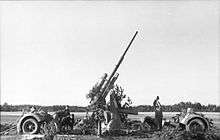
The Flak 18 was mounted on a cruciform gun carriage. A simple-to-operate "semi-automatic" loading system ejected fired shells, allowing it to be reloaded by simply inserting a new shell into a tray. The gun would then fire, recoil, and, during the return stroke, the empty case would be thrown backward by levers, a cam would then engage and recock the gun. This resulted in firing rates of 15 to 20 rounds a minute, which was better than similar weapons of the era. High explosive ammunition was used against aircraft and personnel, and armour-piercing and high-explosive anti-tank against tanks and other armored vehicles.
Widespread production started with the Nazi rise to power in 1933, and the Flak 18 was available in small numbers when Germany intervened in the Spanish Civil War. It quickly proved to be the best anti-aircraft weapon then available. The flak detachment with 88s proved accurate and versatile in combat against mainly land targets, the high muzzle velocity and large caliber making it an excellent long-range anti-vehicle and anti-bunker weapon. This experience also demonstrated a number of minor problems and potential improvement opportunities.
Many of these improvements were incorporated into the Flak 36, which had a two-piece barrel for easier replacement of worn liners. The new, heavier, carriage allowed it to fire in an emergency when still on its wheels and without its outriggers, but with a very limited traverse and elevation.[2] For normal emplacement, one single-axle bogie was detached from the front outrigger and one from the rear, side outriggers were then hinged from the vertical position to the ground; the total time to set up was estimated at two and a half minutes.[2] Both modes of operation made the gun much more suitable for fast-moving operations, the basic concept of the blitzkrieg.
.jpg)
Flak 36s were often fitted with an armoured shield that provided limited protection for the gunners. These shields could be retro-fitted on older Flak 18s as well. The weight of the gun meant that only large vehicles could move it, the SdKfz 7 half-track became a common prime mover.
Targeting indicators were attached from the central controller to each of the four guns of a battery, allowing for coordinated fire. Indeed, with the automatic loading system, the gun layers' job was to keep the gun barrel trained on the target area based on the signals from the controller. The loaders would keep the weapon fed with live ammunition which would fire immediately upon insertion—all while the gun layer aimed the weapon according to the data.
The later model was the Flak 37 which included updated instrumentation to allow the gun layers to follow directions from the single director more easily. Some sources mistakenly cite that the Flak 37 was not equipped for anti-armor purposes. The fact is all 8.8 cm Flak guns were capable of the dual role.[9]
The parts of the various versions of the guns were interchangeable, and it was not uncommon for various parts to be "mixed and matched" on a particular example.[9]
Second generation: Flak 41
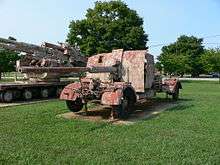
As early as 1939 the Luftwaffe asked for newer weapons with an even better performance, to address the problems of defending against attack by high-flying aircraft. Rheinmetall responded with a new 88 mm design with a longer cartridge and a longer barrel.[10]
A prototype was ready in early 1941[10] leading to the designation 8.8 cm Flak 41. The new gun fired a 9.4-kilogram (20 lb) shell at a muzzle velocity of 1,000 m/s (3,280 ft/s), giving it an effective ceiling of 11,300 meters (37,100 ft) and a maximum of 14,700 meters (48,200 ft), which General Otto Wilhelm von Renz said to be "almost equal to the 128-mm."[7] It featured a lower silhouette on its turntable mounting than did the 8.8-cm Flak 18/36/37 on its pedestal mounting. The barrel was at first a three-section one with a length of 74 calibers, and then redesigned to dual-section with a length of 72 calibers.[10] Improvements in reloading raised the firing rate, with 20 to 25 rounds a minute being quoted.[7]
Because of problems in service, the guns were almost exclusively used in Germany where they could be properly maintained and serviced. The Flak 41 had the disadvantage of complexity, and was prone to problems with ammunition, empty cases often jamming on extraction. Because of the high cost and complexity of this weapon, the Germans manufactured relatively few of them, 556 in all. The first deliveries were made in March 1943[10] and, as of August 1944, only 157 were fielded; with 318 in January 1945. An unusual hybrid adaptation, known as the Flak 37/41, mounted the Flak 41 gun tube onto the Flak 37 carriage, of which only 13 were produced.
Production history
Thousands of 88 mm guns were produced throughout the war in various models and mounts.
| pre-war | 1939 | 1940 | 1941 | 1942 | 1943 | 1944 | 1945 | Total | |
|---|---|---|---|---|---|---|---|---|---|
| 8.8 cm Flak 18/36/37[1][11] | 2,459 | 183 | 1,130 | 1,998 | 3,052 | 4,712 | 6,482 | 738 | 20,754 |
| 8.8 cm Flak 41[7] | 0 | 0 | 0 | 0 | 48 | 122 | 290 | 96? | 556 |
| 10.5 cm Flak 38/39[11] | ? | 38 | 290 | 509 | 701 | 1,220[7] | 1,331[7] | 92 | more than 4,181 |
| 12.8 cm Flak 40 (including twins)[7][11] | 0 | 0 | 0 | 0 | 65 | 298 | 664 | 98 | 1,125 |
Compared to other artillery types, German industry built for example, 570 heavy (caliber 88–128 mm) flak guns, 1,020 field artillery pieces (caliber 75–210 mm), and 1,300 tank guns, anti-tank guns, plus self-propelled guns in December 1943.
Combat history
German use
The eighty-eight was used in two main roles: as a mobile heavy anti-aircraft and anti-tank gun, in support of the troops at the front; and as a more static anti-aircraft gun for home defence.
Anti-aircraft defense of the Reich
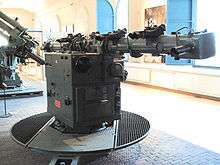
After 1935, the anti-aircraft defense of Nazi Germany was controlled by the Luftwaffe.[7] By the beginning of World War II the Luftwaffe's anti-aircraft artillery employed 6,700 light (2 cm and 3.7 cm) and 2,628 heavy flak guns. Of the latter, a small number were 10.5 cm Flak 38s or 39s, the majority were 8.8 cm Flak 18s, 36s or 37s.[7] This was twice as many heavy AA guns as the Air Defence of Great Britain (ADGB) had at the time, with France and the United States having even fewer.[7]
Throughout the entire war, the majority of 88 mm guns were used in their original anti-aircraft role.[7]
The financial costs associated with anti-aircraft cannon were substantial, especially when compared with fighter aircraft.[7] For example, in January 1943 – at a time Germany was desperately fighting to regain the strategic initiative in the East and was also facing a heavy bombing campaign in the West – expenditures on anti-aircraft defenses were 39 million reichsmarks, whereas all the remaining weapons and munitions production amounted to 93 million (including 20 million of the navy budget and only nine million of the aircraft-related budget).[7]
By August 1944, there were 10,704 Flak 18, 36 and 37 guns in service, now complemented also by the formidable 12.8 cm Flak 40, owing to the increase in US and British bombing raids during 1943 and 1944. There were complaints that, due to the apparent ineffectiveness of anti-aircraft defenses as a whole, the guns should be transferred from air defense units to anti-tank duties, but this politically unpopular move was never made.
Support of ground troops

The 8.8 cm Flaks performed well in its original role of an anti-aircraft gun and it proved to be a superb anti-tank gun as well. Its success was due to its versatility: the standard anti-aircraft platform allowed gunners to depress the muzzle below the horizontal, unlike most of its contemporaries. As WW2 progressed, it was becoming increasingly clear that existing anti-tank weapons were unable to pierce the armor of heavier enemy tanks and ground commanders began increasingly to use the 8.8 cm Flak against tanks.
Similarly to the anti-aircraft role, as an anti-tank weapon the 8.8 cm Flak was tactically arranged into batteries, usually four guns to each. The higher-level tactical unit was usually a mixed anti-aircraft battalion (gemischte Flak-Abteilung).[N 4] It totaled 12 such guns on average, supplanted by light guns.
The German Condor Legion made extensive use of the 8.8 cm Flak 18 in the Spanish Civil War, where its usefulness as an anti-tank weapon and general artillery piece exceeded its role as an anti-aircraft gun. For the Battle of France in 1940, the army was supported by eighty-eights deployed in twenty-four mixed flak battalions.[7] The 8.8 cm Flak was used against heavily armored tanks such as the Char B1 bis and Matilda II, whose frontal armour could not be penetrated by the standard light 3.7 cm anti-tank gun. The 8.8 cm Flak was powerful enough to penetrate over 84 mm of armor at a range of 2 km, making it an unparalleled anti-tank weapon during the early days of the war and still formidable against all but the heaviest tanks at the end.[12] Erwin Rommel's use of the gun to blunt the British counterattack at Arras ended any hope of a breakout from the encirclement of May 1940. In the entire Battle of France, the weapon destroyed 152 tanks and 151 bunkers.[7] The Battle of France also saw the introduction of vehicle mounted 8.8 cm Flak 18s, the so-called "Bunkerknacker" on the SdKfz 8 heavy tractor.

During the North African campaign, Rommel made the most effective use of the weapon, as he lured tanks of the British Eighth Army into traps by baiting them with apparently retreating German panzers. A mere two flak battalions destroyed 264 British tanks in 1941.[7] Repeated high tank loss from well-placed 8.8 cm Flak guns in the battles of Halfaya Pass earned it the nickname "Hellfire Pass". Later in that theater, in the Battle of Faid in Tunisia, Rommel camouflaged many 8.8 cm Flaks (with additional 7.5 cm Pak 40s and 5 cm Pak 38s) in cactus-filled areas. Inexperienced U.S. tankers and commanders rushed into a valley at Faid only to be obliterated. When the U.S. Army's M3 Stuart and M4 Sherman tanks pursued, concealed German guns picked them off at ranges far beyond those of their 37mm and 75 mm guns respectively.
For Operation Barbarossa, the invasion of the Soviet Union, Germany deployed the 8.8 cm Flak in 51 mixed AA battalions.[13] They were mostly[7] Luftwaffe-subordinated units attached to the Heer at corps or army level, with approximately one battalion per corps.[14] The weapon saw continuous use on the eastern front. The appearance of the outstanding T-34 and KV tanks shocked the German panzer crews and anti-tank teams, who could only penetrate the Soviet tanks' armor at extremely close range, when using the standard 37 mm and 50 mm guns.
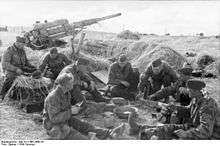
The 8.8 cm Flak in the anti-tank role was arguably most effective in the flat and open terrain of Libya, Egypt and the eastern front. The less open terrain in Italy and Northern France was less suitable for long-range AT guns. The success of the German anti-tank weapons caused the Allies to take steps to defend against it in new tank designs. On July 18 and 19 1944 a Luftwaffe 8.8 cm anti-aircraft battery was re-purposed by then Major Hans von Luck to attack British tanks near Cagny taking part in Operation Goodwood. 20 tanks were killed by these guns within the first few seconds and at least 40 tanks were knocked out by 8.8 cm Flaks during the engagement.[15] By February 1945, there were 327 heavy anti-aircraft batteries facing the Red Army, which was 21 percent of those used for anti-aircraft defense.[7]
Coastal defence
On 14 September 1942, Flak-Abt. I./43 (Major Wegener) employed these guns against a commando landing raid called Operation Agreement by the British Royal Navy near Tobruk, damaging the destroyer HMS Sikh so severely that she sank while being towed by HMS Zulu.
Use by other armed forces
China
In 1937, the Chinese Nationalist Government imported 20 Flak 18 guns and used them to defend the Castles along the Yangtze River. They were captured by the Japanese Imperial Army during the Sino-Japanese War.
Finland
In 1943 - 1944 Finland bought 90 8.8 cm FlaK 37 cannons from Germany and they were used for air defence of largest cities in Finland. These cannons played an important role against Soviet air raids in Helsinki in February 1944. After the war these cannons remained in Finnish use as AA-guns until 1977 and after that as coastal guns until the early 2000s.[16] The gun had nickname Rämäpää ("Reckless") after the manufacturer's initials RMB. Several of the Finnish guns survive in museums and as memorials.
Spain
Four batteries (16 guns) of 88mm guns (Flak. 18) initially reached Spain as AA with the Condor Legion in 1936, but it was soon used as anti-tank, anti-bunker and even as anti-battery. More guns were sent later, and some more 88-mm guns were supplied to Spanish army units. At the end of the war the Spanish Army was using all of the Flak 18 guns sent, some 52 units.
Initially, the Flak 18 batteries were deployed to protect the airfields and logistics bases used by German Condor legion. The scarcity of artillery among the Nationalist forces and the general low proficiency of the Spanish gun crews forced the usage of the Flak 18 gun in a variety of roles, including as an artillery piece and as an anti-tank gun. Given appropriate ammunition it proved quite capable in both roles.[17] The war in Spain, with its wildly fluctuating front lines and the presence of Russian tanks, forced the Germans to employ the Flak 18 guns in a direct fire mode against ground targets. By the end of the war the 88-mm guns had performed far more missions as an anti-tank and direct-fire Field Artillery gun than as an anti-aircraft gun. During the war German 88-mm guns were involved in 377 combat engagements, only 31 were against enemy aircraft. The use of the 88-mm direct support of the infantry brought the gun crews in close proximity to the enemy and made the crews susceptible to infantry fire. Casualties among the legion's 88-mm gun batteries in the Spanish Civil War were second only to those among the bomber pilots.
In early 1937 in the fighting around Malaga, a battery of 88-mm guns was assigned to support an infantry brigade. Bad weather grounded the main bomber force, but the assault succeeded, mainly because of the concentrated and accurate fire of the supporting 88-mm guns. Flak 18 batteries were by the nationalist army at the Battle of Ebro, used for direct fire against pillboxes and for indirect fire in the advance towards Barcelona.
Following the Spanish Civil war, more Flak. 36 models arrived in 1943 (88 guns 88/56 mm Flak-36) and since 1943 they were manufactured under license in Trubia under the denomination FT 44 (about 200 guns).
Allied
The Flak 36 guns were briefly issued in late 1944 to the American Seventh Army as captured weapons. The 79th Field Artillery Battalion (Provisional) was formed from personnel of the 79th and 179th Field Artillery Groups to fire captured German artillery pieces at the height of an ammunition shortage. Similarly, the 244th Field Artillery Battalion was temporarily equipped with a miscellany of captured German 88mm guns and 105mm and 150mm howitzers. As of December 31, 1944, the 244th Field Artillery Battalion had fired a total of 10,706 rounds through captured German weapons.[18]
Yugoslavia
During the Yugoslav wars in the 1990s, various Flak guns were used, mainly by the naval artillery of the Yugoslav People's Army (JNA). The Serbian Army (VJ) also used Flak carriages mounted with double 262 mm rocket launch tubes from the M-87 Orkan MLRS, instead of the 88mm gun. It was capable of deploying cluster bombs, as well as anti-personnel and anti-tank mines, at up to 50 km. Only a few were built in mid-1993, the entire project was generally regarded as unsuccessful.[19]
Comparison with similar anti-aircraft guns
The Flak 18/36/37 was roughly comparable to its Italian and Allied counterparts. As an anti-aircraft gun it fired a 9.2 kilogram (20 lb) shell at a muzzle velocity of 840 m/s to an effective ceiling of 8000 meters, [20] with a maximum ceiling of 9900 meters. [2] While this was potent against US daylight raids, which generally flew at altitudes of 6400 to 7600 meters, some aircraft were able to fly higher than the gun's effective ceiling. Some flak batteries used guns worn out from firing beyond their operational lives, which typically limited their effective ceiling to 7470 meters.[21]
In comparison, the British 3.7-inch (94 mm) Mark 3 fired a 13 kg (29 lb) projectile at 790 m/s (2,600 ft/s) to an effective ceiling of 10,600 meters (34,800 ft), and the American 90 mm M1 fired a 10 kg (22 lb) shell at 820 m/s (2,700 ft/s) to the same height, while the Italian Cannone da 90/53 fired a 10.33 kg projectile at 830 m/s to an effective ceiling of 12,000 meters (39,000 ft). The Allied weapons' capabilities were augmented by the introduction of proximity fuses, which vastly increased their effectiveness. The Allies' and Italian weapons were heavier and less mobile, with the Allied weapons being almost useless for ground fire until numerous modifications were carried out. While the US and Italian 90 mm were also used as anti-tank guns — the American gun being in use on their M36 tank destroyer and M26 Pershing heavy tank — their use was considerably more limited than the German 88.
Related developments
KwK 36
The KwK 36 (abbreviation of Kampfwagenkanone 36) was a tank gun developed and built by Krupp in parallel to the Flak 36, with which it shared ammunition and ballistics. It was the main armament of the Tiger I heavy tank.
PaK 43 and KwK 43

At the time that Rheinmetall developed the Flak 41, Krupp tried to compete with their 8.8 cm Gerät 42 proposal, which was not accepted for production as an anti-aircraft gun. Krupp continued development, resulting in the dreaded 8.8 cm PaK 43 anti-tank gun and the related 8.8 cm KwK 43 tank gun.
The PaK 43 (an abbreviation of Panzerjägerkanone 43[22][23]) used a new cruciform mount with the gun much closer to the ground, making it far easier to hide and harder to hit. It was also provided with a much stronger and more angled armour shield to provide better protection to the crew. In addition to the towed version, there were also self-propelled versions of the PaK 43 gun, including the lightly armored Nashorn, and the strongly armored, fully casemate-enclosed Elefant and Jagdpanther tank destroyers.
All versions were able to penetrate about 200 mm (7.9 inches) of armour at 1,000 m (3280 feet), allowing it to defeat the armor of any contemporary tank.
The main armament of the Tiger II heavy tank, the KwK 43 tank gun, was the PaK 43 adapted for tank use, and it was considered for the Panther II tank.
The 88 "family"
Guns using the 88×571R mm cartridge
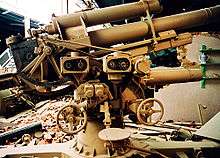
- 8.8 cm Flak 18 Had a new semi-automatic breech, making it a rapid fire gun. It entered production in Germany in 1933 and used the Sonderanhänger 201 trailer. its weight was seven tonnes. Its rate of fire was 15 to 20 rounds per minute. It was later fitted with a gun shield to protect the crew when engaging ground targets. It was produced by Krupp.
- Mod 1938 II: Approximately 50 guns were modified so a single man could adjust the elevation and traverse.
- 8.8 cm Flak 36 Entered service 1936–37. It used the redesigned trailer Sonderanhänger 202 which enabled a faster time into action from the move. The SdAnh 202 had twin wheels on two similar carriages. It could engage ground targets from the traveling position. Its weight was seven tonnes. Its rate of fire was 15 to 20 rounds per minute. It was produced by Krupp. It was subsequently fitted with a shield to protect the crew when engaging ground targets.
- 8.8 cm KwK 36: The main gun of the PzKw VI Ausf. E (Tiger I) tank. Despite its designation, some classify it as a parallel development with very similar specifications rather than a derivative of the Flak 36.
- 8.8 cm Flak 37: It was an updated version of the Flak 36, the main difference being Übertragungser 37 (a data transmission system). It was produced by Krupp.
Guns using the 88×855R mm cartridge
- 8.8 cm Flak 41: This was a weapon developed and produced by Rheinmetall-Borsig to be used with an 855 mm cartridge case.[24] It was fitted to the existing Sonderanhänger 202 as standard and entered service in 1943. The barrel was at first designed as three-section with a length of 74 calibers, and then redesigned to dual-section with a length of 72 calibers.[10]
Guns using the 88×822R mm cartridge
- 8.8 cm Gerät 42: Was a new Krupp design to compete with the Flak 41; it did not enter service as an anti-aircraft gun. Further development of the weapon led to the Pak 43 anti-tank gun.
- 8.8 cm Pak 43: An anti-tank model developed from Krupp's 8.8 cm Gerät 42. With a new gun carriage, the Sonderanhänger 204 was developed by Krupp and manufactured in different versions, including the KwK 43, by at least Dortmund Hoerder-Hüttenverein, Henschel, Weserhütte and Fr. Garny. It had a 71 caliber barrel and an 822 mm cartridge case.[24]
- 8.8 cm Pak 43/41: The Pak 43 was mounted on a single axle split-trail field gun carriage which was produced as a stop-gap measure due to the scarcity of materials. Its weight was 4.9 tonnes.
- 8.8 cm Pak 43/1: The Pak 43 mounted in the Nashorn tank destroyer.
- 8.8 cm Pak 43/2 The Pak 43 mounted in the Ferdinand/Elefant tank destroyer. It was occasionally referred to as the "StuK 43/1", the abbreviation standing for Sturm-Kanone (assault gun).
- 8.8 cm Pak 43/3 and 43/4: The Pak 43 mounted in the Jagdpanther tank destroyer. It had a falling wedge breech block.
- 8.8 cm KwK 43: The Pak 43 modified as a tank gun. It was the main gun of the Tiger II heavy tank. It also had a falling wedge breech block.
Surviving examples
The following museums include 8.8 cm Flak guns in their collections.
- Virginia War Museum, Newport News, Virginia. One 76mm hole in outrigger.
- Heeresgeschichtliches Museum, Vienna, Austria
- Military Museum, Belgrade, Belgrade, Serbia
- Imperial War Museum Duxford, Duxford, UK
- Imperial War Museum, London, UK
- Muckleborough Collection Norfolk, UK
- United States Army Air Defense Artillery Museum, Fort Sill, Oklahoma, US (Flak 18, Flak 36, Flak 37, Flak 41, 8,8 cm Flak M39(r))
- National Museum of the United States Air Force, Dayton, Ohio, US[25]
- Canadian War Museum, Ottawa, Canada
- Deutsches Panzermuseum, Munster, Germany
- Aviation Museum Hannover-Laatzen, Germany
- Le Grand Bunker "Musée du Mur de l´Atlantique", Ouistreham, France
- Overloon War Museum, Overloon, Netherlands
- Atlantikwall-Museum, Hoek van Holland, Netherlands
- Ilmatorjuntamuseo, Hyrylä, Finland
- Museo Histórico Militar, A Coruña, Spain[26]
- National Military Museum, Romania, Bucharest
- Australian Armour and Artillery Museum, Cairns, Australia
- The Vintage Aviator (privately owned by Peter Jackson), Masterton, New Zealand
- The Flying Heritage Collection, Everett, Washington, US
- National Naval Museum of Tigre, Argentina
- Kuivasaari Artillery Museum, Helsinki, Finland
- Military Aviation Museum Virginia Beach, Va, US (Flak 37 in working condition)
- South African Museum of Military History Johannesburg, South Africa
- Wehrtechnische Studiensammlung Koblenz, Germany
- Palm Springs Air Museum, Palm Springs, California
- National WWII Museum, New Orleans, LA, USA
Gallery
-

Flak 37 gun at the Deutsches Panzermuseum, Munster, Germany
-
Flak 37 gun at the Anti-aircraft Museum in Hyrylä, Finland
-
8.8 cm High-explosive shell
-

Flak 18 gun in position at Bir Hakeim, North Africa, June 1942
-
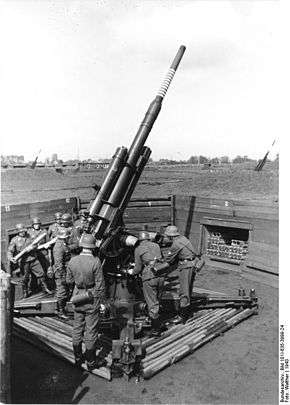
Flak battery in firing position, Germany, 1943
-

FuMG 39 “Würzburg” radar at an anti-aircraft position on the Atlantic Wall, France, 1942
-

Fort Bliss Museum German 88
See also
Weapons of comparable role, performance and era
- Bofors 75 mm Model 1929 : 75 mm and 80 mm Swedish gun developed alongside the 88 at Bofors
- QF 3.7-inch AA gun : contemporary British anti-aircraft gun, firing a heavier (28 pounds (13 kg)) shell
- Cannone da 90/53 : contemporary Italian anti-aircraft gun
- 90 mm Gun M1 : contemporary US anti-aircraft gun
- 85 mm air defense gun M1939 (52-K) : contemporary Soviet anti-aircraft gun
References
Explanatory notes
- 1 2 In German, the comma is used as the decimal separator, hence official punctuation was actually "8,8 cm" and not "8.8 cm". The spoken version was Acht-komma-acht Zentimeter.
- ↑ Also many sources say Flak is a contraction of Flugabwehrkanone[4] or Fliegerabwehrkanone or Flugzeug-Abwehr-Kanone.[5] In all cases, including the latter, the letter "k" in "Flak" was not capitalized, as it did not signify an abbreviation of the German word Kanone.
- ↑ The Allied slang for anti-aircraft fire, ack-ack, does not come from the Acht-acht, but is World War I signalers' phonetic spelling of letters "AA".[6]
- ↑ The light anti-aircraft battalion usually did not deploy any 8.8 cm Flaks, the heavy battalions were rarely used in practice.
Citations
- 1 2 "Lexikon der Wehrmacht - Flugabwehrwaffen (Flak)"
- 1 2 3 4 5 6 "TM E9-369A: German 88-mm Antiaircraft Gun Materiel - Technical Manual, U.S. War Department, June 29, 1943 (Lone Sentry)". Retrieved 23 December 2014.
- ↑ W. Biedermann (1923). Die deutsche Sprache als Spiegel deutscher Kultur. Frommannsche Buchhandlung. p. 38.
Flak (Flugzeugabwehrkanone)
- ↑ Oberkommando des Heeres H.Dv.481/541 - Merkblatt für die Munition der 8,8 cm Flugabwehrkanone 18 (8,8 cm Flak 18) und der 8,8 cm Flugabwehrkanone 36 (8,8 cm Flak 36); Berlin: Oberkommando des Heeres, 1942.
- ↑ Wilhelm Oppermann, 1928.
- ↑ "Free Web Hosting - Unlimited Web Space and Transfer with PHP Mysql and No Popups or Banners". Retrieved 23 December 2014.
- 1 2 3 4 5 6 7 8 9 10 11 12 13 14 15 16 17 18 19 20 Westermann, Edward B. (2005–2009) [2001]. Flak: German Anti-aircraft Defenses 1914-1945. Modern War Studies. University Press of Kansas. pp. 19, 36–38, 44, 53, 58, 83, 90, 108, 128–129. ISBN 9780700614202.
- ↑ "88mm Flak Series – Flugabwehrkanone". Retrieved 23 December 2014.
- 1 2 Chow, Roy Troy, MI, 06 Feb 2012. Retrieved on 08 Oct 2014.
- 1 2 3 4 5 Norris, John (2002-01-01). 88 Mm FlaK 18/36/37/41 & PaK 43, 1936-1945: 1936 - 45. p. 15. ISBN 9781841763415.
- 1 2 3 "German Weapon and Ammunition Production"
- ↑ Penetration of the Pzgr. 39 ammunition against a 30-degree sloped steel plate: http://www.panzerworld.net/armourpenetration
- ↑ http://www.operationbarbarossa.net/OBTCMS/Part-V/German-Deployment-matrix.pdf
- ↑ "Barbarossa Order of Battle". Retrieved 23 December 2014.
- ↑ Hans Von Luck (1989). Panzer Commander, Dell Books. pp 193-198. ISBN 0-440-20802-5
- ↑ "FINNISH ARMY 1918 - 1945: ANTIAIRCRAFT GUNS PART 3". Retrieved 23 December 2014.
- ↑ "U.S. Military Intelligence Report: German Anti-Aircraft Artillery" (PDF). February 8, 1943. p. 37. Retrieved February 4, 2015.
- ↑ "244th Field Artillery Battalion". Retrieved 23 December 2014.
- ↑ “Kalibar” br.106 iz avgusta 2005.godine
- ↑ Askey, Nigel (2014). Operation Barbarossa: the Complete Organisational and Statistical Analysis, and Military Simulation Volume IIB. Lulu Publishing. p. 90. ISBN 9781312413269.
- ↑ Westermann, Edward B (2001). Flak German Anti Aircraft Defenses 1914-45. University Press of Kansas. pp 293. ISBN 978-0700614202.
- ↑ D 2030 – 8,8 cm Panzerjägerkanone 43/2 (L/71), Beschreibung, 28.1.1944. Berlin.
- ↑ D97/1+ Gerätliste, Oberkommando des Heeres Heereswaffenamt, s.45, Berlin 1.7.43
- 1 2 Williams, Anthony G. "78- 100 MM CALIBRE CARTRIDGES". AMMUNITION DATA TABLES. Retrieved 30 July 2011.
- ↑ "Flak 36 88mm Multipurpose Gun." National Museum of the United States Air Force. Retrieved: 5 August 2015.
- ↑ "Cañones para Hitler en A Coruña: el Monte de San Pedro". Retrieved 23 December 2014.
Bibliography
- Chant, Christopher. Artillery of World War II. London: Brown Partworks, 2001. ISBN 1-84044-088-0.
Further reading
- Gander, Terry, and Peter Chamberlain. Weapons of the Third Reich: An Encyclopedic Survey of All Small Arms, Artillery and Special Weapons of the German Land Forces 1939–1945. New York: Doubleday, 1979. ISBN 0-385-15090-3.
- Hogg, Ian V. German Artillery of World War Two. 2nd corrected edition. Mechanicsville, Penn.: Stackpole Books, 1997. ISBN 1-85367-480-X.
- Piekalkiewicz, Janusz (translated by Edward Force) (1992). The German 88 Gun in Combat: The Scourge of Allied Armor. Schiffer Military History. ISBN 978-0-88740-341-5.
External links
| Wikimedia Commons has media related to 8.8 cm FlaK 18/36/37/41. |
- History of the 88 mm series of guns
- US Military Intelligence document on the 88 mm gun
- The New 88 and Its Carriages
- Detailed examination of the effect of 88 mm FlaK on B-17 and B-24 bombers
- Technical Manual German 88 mm Antiaircraft Gun Materiel - US War Department, 29 June 1943
- Extract from "Handbuch für den Flakartilleristen" - Die 8.8 cm – Flak 1939

